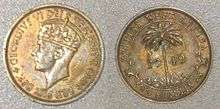British West African pound
The British West African Pound was once the currency of British West Africa, a group of British colonies, protectorates and mandate territories. It was equal to the pound sterling and was similarly subdivided into 20 shillings, each of 12 pence. This currency is now obsolete.
History
In the 19th century, the pound sterling became the currency of the British West African territories and standard issue United Kingdom coinage circulated. The West African territories in question were Nigeria, the Gold Coast (now Ghana), Sierra Leone and The Gambia.
In 1912,[1] the authorities in London set up the West African Currency Board and issued a distinctive set of sterling coinage for use in British West Africa. The circumstance prompting this move was a tendency for existing UK coins used in the West African territories to leave the region and return to the UK, hence causing a local dearth of coinage. A unique British West African variety of the sterling coinage would not be accepted in the shops of Britain and so would remain in circulation locally.
There was a precedent for this move: in 1910, Australia had already commenced issuing its own distinctive varieties of sterling coinage, but the reasons for doing so were quite different from those relating to British West Africa. Australian authorities issued local coinage as a step towards full nationhood. With the exception of Jamaica where special low denomination coins were issued in place of the United Kingdom copper coins, due to local superstitions surrounding the use of copper coinage for church collections, authorities in London did not replace any UK sterling coins with local issues for any other British colony.
The British West African pound was also adopted by Liberia in 1907, replacing the Liberian dollar, although it was not served by the West African Currency Board. Liberia changed to the U.S. dollar in 1943. Togo and Cameroon adopted the West African currency in 1914 and 1916 respectively, when British and French troops took over those colonies from Germany as part of World War I.
Beginning in 1958, the British West African pound was replaced by local currencies in the individual territories. The replacements were:
| Country | Date | New Currency |
Conversion Rate From BWA pound |
| Western Nigeria | 1958 | Nigerian pound | 1 |
| Ghana | 1958 | Ghanaian pound | 1 |
| Nigeria | 1958 | Nigerian pound | 1 |
| British Cameroon | 1961 | CFA franc | 700 |
| Sierra Leone | 1964 | Leone | 2 |
| Gambia | 1968 | Gambian pound | 1 |
Coins


In 1907, aluminium 1⁄10 penny and cupro-nickel 1 penny coins were introduced. Both coins were holed. In 1908, cupro-nickel replaced aluminium in the 1⁄10 penny and, in 1911, holed, cupro-nickel ½ penny coins were introduced. In 1913, silver 3 and 6 pence, 1 and 2 shillings were introduced. In 1920, brass replaced silver in these denominations.
In 1938, larger, cupro-nickel 3 pence coins were introduced, with nickel-brass replacing brass in the higher denominations. In 1952, bronze replaced cupro-nickel in the 1⁄10, ½ and 1 penny coins. The last coins of British West Africa (pennies) were struck in 1958.
Banknotes
In 1916, the West African Currency Board introduced notes for 2, 10 and 20 shillings, followed by 1 shilling notes in 1918. Only the 10 and 20 shillings notes were issued after 1918, until 100 shillings (5 pounds) notes were introduced in 1953. The last notes (20 shillings) were produced in 1962.
See also
- Gambian pound
- Ghanaian pound
- Gold Coast ackey
- Nigerian pound
- West African Monetary Zone
- Economic Community of West African States
References and sources
- References
- ↑ "The West African Currency Board - Some Notes with a Nigerian Bias" by Bob Maddocks in Cameo, Journal of the West Africa Study Circle, Vol. 13, No. 2, June 2012, pp. 106-108.
- Sources
- Krause, Chester L.; Clifford Mishler (1991). Standard Catalog of World Coins: 1801–1991 (18th ed.). Krause Publications. ISBN 0873411501.
- Pick, Albert (1994). Standard Catalog of World Paper Money: General Issues. Colin R. Bruce II and Neil Shafer (editors) (7th ed.). Krause Publications. ISBN 0-87341-207-9.